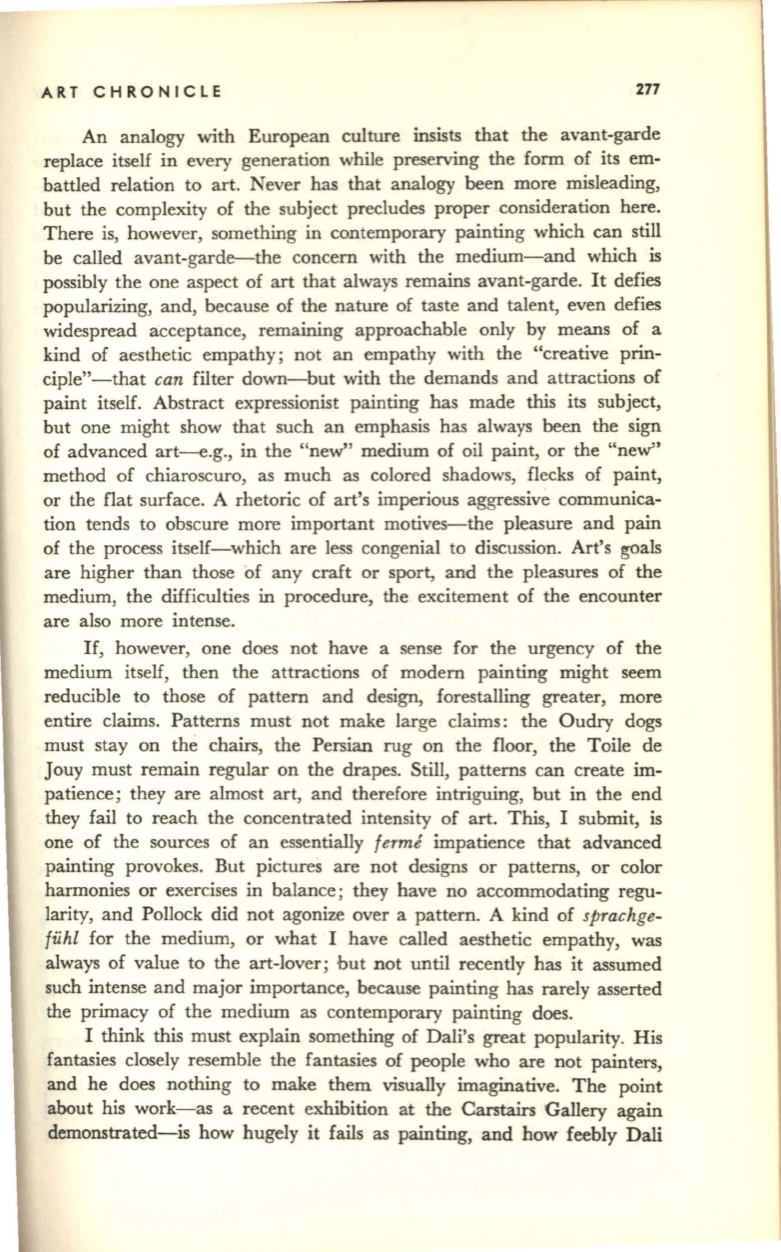
ART CHRONICLE
277
An analogy with European culture insists that the avant-garde
replace itself in every generation while preserving the form of its em–
battled relation to art. Never has that analogy been more misleading,
but the complexity of the subject precludes proper consideration here.
There is, however, something in contemporary painting which can still
be called avant-garde--the concern with the medium-and which is
possibly the one aspect of art that always remains avant-garde. It defies
popularizing, and, because of the nature of taste and talent, even defies
widespread acceptance, remaining approachable only by means of a
kind of aesthetic empathy; not an empathy with the "creative prin–
ciple"-that
can
filter down-but with the demands and attractions of
paint itself. Abstract expressionist painting has made this its subject,
but one might show that such an emphasis has always been the sign
of advanced art-e.g., in the "new" medium of oil paint, or the "new"
method of chiaroscuro, as much as colored shadows, flecks of paint,
or the flat surface. A rhetoric of art's imperious aggressive communica–
tion tends to obscure more important motives-the pleasure and pain
of the process itself-which are less congenial to discussion. Art's goals
are higher than those of any craft or sport, and the pleasures of the
medium, the difficulties in procedure, the excitement of the encounter
are also more intense.
If,
however, one does not have a sense for the urgency of the
medium itself, then the attractions of modern painting might seem
reducible to those of pattern and design, forestalling greater, more
entire claims. Patterns must not make large claims: the Oudry dogs
must stay on the chairs, the Persian rug on the floor, the Toile de
Jouy must remain regular on the drapes. Still, patterns can create im–
patience; they are almost art, and therefore intriguing, but in the end
they fail to reach the concentrated intensity of art. This, I submit, is
one of the sources of an essentially
ferme
impatience that advanced
painting provokes. But pictures are not designs or patterns, or color
harmonies or exercises in balance; they have no accommodating regu–
larity, and Pollock did not agonize over a pattern. A kind of
sprachge–
fuhl
for the medium, or what I have called aesthetic empathy, was
always of value to the art-lover; but not until recently has it assumed
such intense and major importance, because painting has rarely asserted
the primacy of the medium as contemporary painting does.
I think this must explain something of Dali's great popularity. His
fantasies closely resemble the fantasies of people who are not painters,
and he does nothing to make them visually imaginative. The point
about his work-as a recent exhibition at the Carstairs Gallery again
demonstrated-is how hugely it fails as painting, and how feebly Dali


